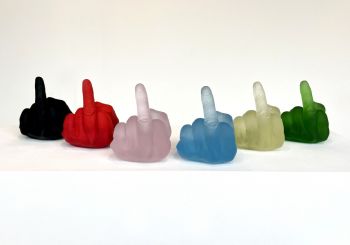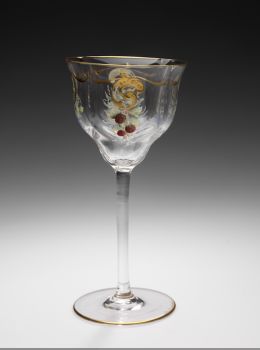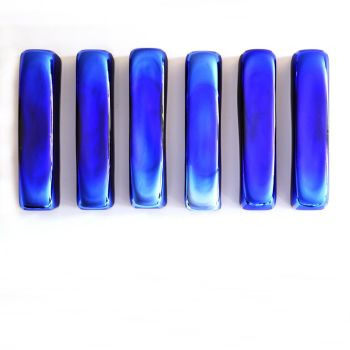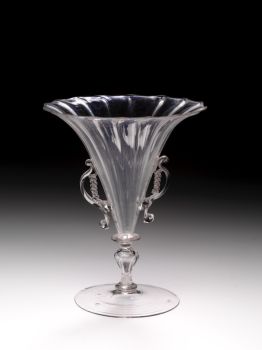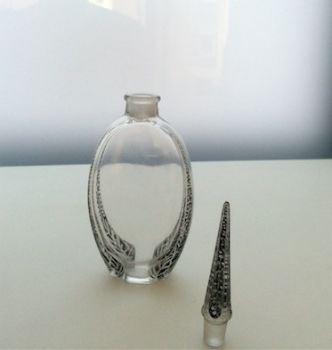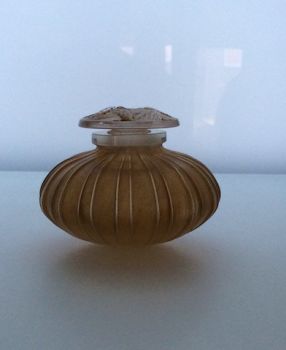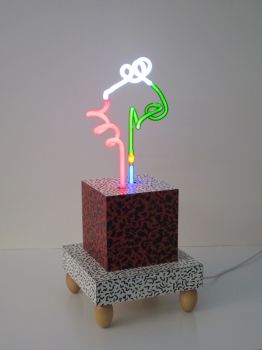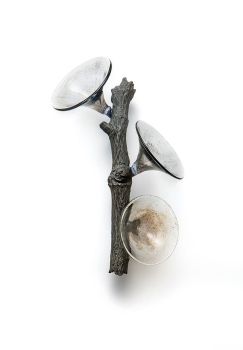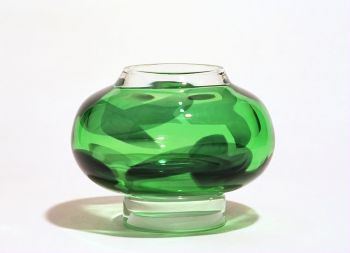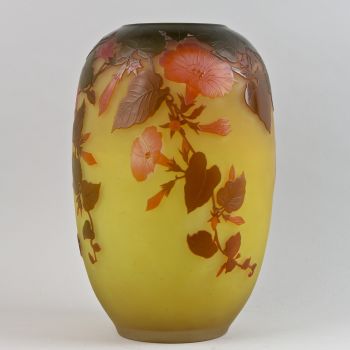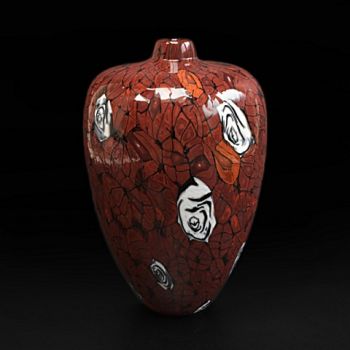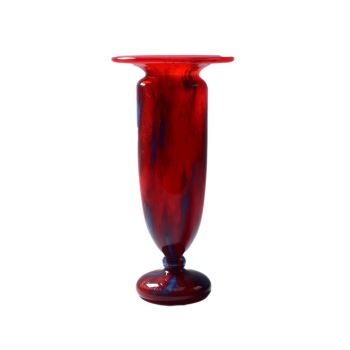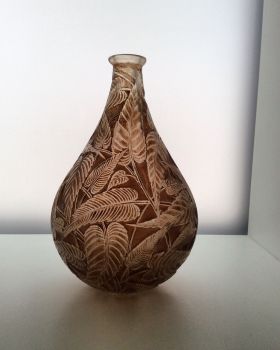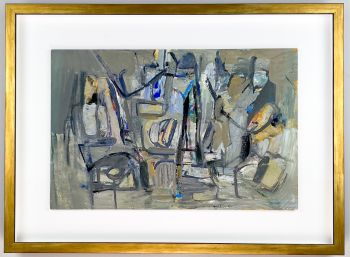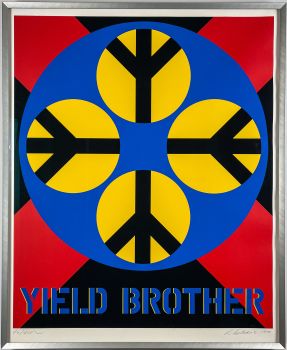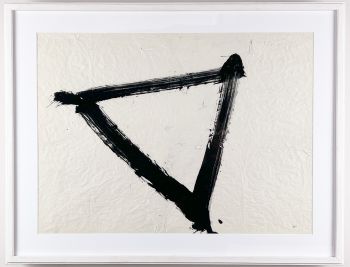A largest size glass art-object "Pajunlehti" or "Willowleaf" in unusual colour light-brown, model KF 1960 - 1965
Kaj Franck
Vidrio
4 ⨯ 24 ⨯ 9 cm
ConditionVery good
€ 750
Van Kerkhoff Art
- Sobre la obra de arteA free blown, flared, cut and polished light brown and clear cased glass art-object "Pajunlehti" or "Willowleaf", model KF 210. Designed by Kaj Franck in 1954 and executed by the Nuutajärvi-Notsjö glassworks circa 1960.
These art-objects were made in three different size-ranges and several colours between 1954 and 1963. This being a largest size example in a unusual light brown colour. The same colour used in the Nuutajärvi-Notsjö glassworks for one of the "Prisma" variants.
This Wilowleaf is etched-signed underneath the base. The etching has faded though and only K. F. remains readable. Either it was signed this way or the rest of the designers name has faded. The piece is in good condition, scratches underneath the base but no cracks or chips.
About Kaj Franck
Kaj Franck (Vyborg, Finland 1911 – Santorini, Greece 1989) was an influential Finnish designer and leading figure in Finnish art-world between 1940-1980.
Born in 1911 on the Finnish Russian border in a family of architects (his grandfather was director of the famous Arabia Ceramics factory) of Finnish-German-Swedish decent.
He attended the furniture department of Taideteollinen korkeakoulu (todays Aalto university school of Arts, Design and Architecture) in Helsinki.
After his studies he worked as a freelance designer until he joined Arabia as a designer in 1945. In 1950 he became Arabia’s Artistic Director. He also designed glass-objects for Iittala between 1946 and 1950 and between 1950 and 1976 for Nuutajärvi-Notsjö glassworks.
From 1945 onwards he worked as and educator at Taideteollinen korkeakoulu and he became the institute's Artistic Director in 1960.
His modernist designs in everyday tableware glass are considered to be a revolution and classic Finnish design object (most notably his Kilta tableware and Kartio glassware).
He is often referred to as “the conscience of Finnish design”, moderation, ecology and equality were Franck’s principles. He strove to minimise the number of everyday objects we need in our lives, drawing attention to the sustainability and life cycle of products.
Kay Franck’s designs are in collections of numerous museums all over the world. Among others: Design Museum Helsinki, Museum of Modern Art, New York, Stedelijk Museum Amsterdam and The British Museum, London. He was a recipient of many prizes. Most notably the Lunning prize in 1955, a “Grand prix” and several “Gold medals” at the Triennale di Milano.
Today his name is used for the prestigious “The Kaj Franck Design Prize” annually awarded by the Finnish Design Forum.
Execution
Nuutajärvi-Notsjö glassworks, Finland circa 1960
Marked
Etched-signed underneath the base. The etching has faded though and only K. F. remains readable. Either it was signed this way or the rest of the designers name has faded.
Condition
This art-object is in good vintage condition, some minor scratches and wear consistent with age and use. No chips or cracks.
Literature
Marianne Aav (ed.), Kaj Franck, Universal Forms, p.322
Dimensions
H. 4.9 cm
W. 24.9 cm
D. 9.8 cm
Weight 843 grams - Sobre el artista
El diseñador finlandés de cerámica y vidrio Kaj Franck (1911-1989) se dio cuenta de una poderosa verdad en su distinguida carrera: lo simple es hermoso. A pesar de que el mundo se mueve a un ritmo cada vez más acelerado, de una década a otra, esa simple verdad permanece. La inspiración y los principios de Franck iniciaron una tradición en el diseño finlandés, que aún hoy sigue viva y fuerte. Sus obras más conocidas son las series Iittala Teema y Kartio, y su herencia forma parte de todos los hogares finlandeses.
“Quiero hacer uso de objetos que son tan obvios que no se notan”, definió Kaj Franck su propio trabajo. Sus diseños atendían las necesidades humanas básicas mientras les servía herramientas con propiedades de objetos cotidianos. Franck también estaba interesado en objetos de bajo Costó la producción en masa y rehuyó el materialismo, la cultura del descarte y la ostentación El mundo de Franck consistía en formas matemáticas básicas y formas simples, decoradas solo con colores fuertes.
El punto de partida del trabajo de Franck fue la practicidad combinada con la belleza. Aunque hoy parece evidente, en su época su pensamiento era radical. Franck separó los estilos y las tendencias de la moda de la tradición y le dio un significado completamente nuevo. En el período de 1952 a 1953, Franck demostró que la vajilla no necesita ser demasiado compleja con el lanzamiento de la serie Kilta como una declaración fuerte: era una idea novedosa que todos podían configurar la mesa según sus propias necesidades.
Franck comenzó sus diseños centrándose en la idea o el concepto subyacente, no en la forma. Este énfasis en el aspecto de la idea del diseño también se trasladó a su trabajo como profesor y más tarde como director artístico en la Universidad de Arte y Diseño de Helsinki. Franck también fue uno de los primeros defensores del reciclaje, y a menudo se le ha llamado la "conciencia del diseño finlandés". Franck ganó muchos premios en su distinguida carrera y se hizo famoso internacionalmente. Hoy en día, el premio Kaj Franck es el reconocimiento de diseño más prestigioso de Finlandia. .
¿Está interesado en comprar esta obra de arte?
Artwork details
Related artworks
- 1 - 4 / 10
- 1 - 4 / 24
Artista Desconocido
François-Théodore Legras – Tall “Fleurs de Pommier” apple blossoms vase1900 - 1909
Precio a consultarAntiques Emporium
Frères Daum
Daum Nancy – “Paysage Soleil Couchant” vase with two applied handles1900 - 1910
Precio a consultarAntiques Emporium
Johann Loetz (Lötz) Witwe Klostermühle
Johann Loetz Witwe - Phänomen Genre 7773 – Orange1900 - 1910
Precio a consultarAntiques Emporium
1 - 4 / 24Artista Desconocido
EIGHT NEO-GOTHIC STAINED GLASS WINDOWS WITH SUSPENSION EYELET, 19th C, BELGIUM.1850 - 1900
Precio a consultarSpectandum Gallery
Artista Desconocido
Vidrio alado veneciano1550 - 1599
Precio a consultarPeter Korf de Gidts - Antiquairs
René Lalique
Un jarrón temprano 'Bluets' diseñado por Rene Lalique (1860-1945)1910 - 1920
Precio a consultarLennart Booij Fine Art and Rare Items
Johann Loetz (Lötz) Witwe Klostermühle
Johann Loetz Witwe – Ausfuehrung 146 Titania vase – 19121910 - 1919
Precio a consultarAntiques Emporium
1 - 4 / 24- 1 - 4 / 12







































